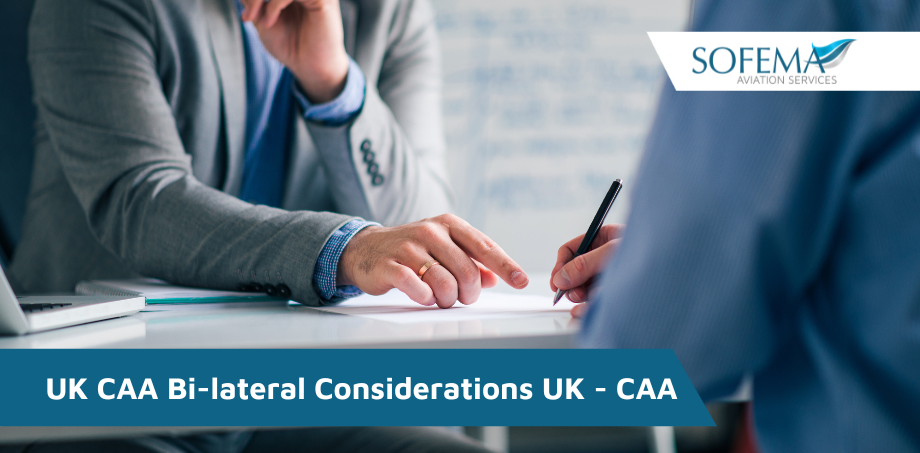Sofema Aviation Services (SAS) www.sassofia.com considers the scope and applicability between UK CAA and EASA relating to Bi-Lateral Certification & Approval.
Introduction – International Co-operation
- Bilateral agreements that allow certification of civil aeronautical products to be shared between two countries.
- Bilateral agreements and arrangements allow the airworthiness certification of civil aeronautical products to be shared between two countries.
- The various agreements and their associated implementing procedures provide for technical cooperation between national civil aviation authorities.
- They help reduce duplication of activity and aim for mutual acceptance of certificates.
Terminology Used
BASA – Bilateral Aviation Safety Agreement
MoU – Memorandum of Understanding (MoU)
WA – Working Arrangement (WA)
Areas of Applicability
In addition to airworthiness certification, BASAs, MoUs, and WAs provide for bilateral cooperation across other areas of aviation, including:
- Maintenance,
- Flight operations, and
- Environmental certification.
Note: For aircraft certification and maintenance, additional implementation procedures will cover specific issues such as:
- Design approval,
- Production acceptance,
- Export airworthiness approval,
- Post-design approval activities,
- Technical cooperation and maintenance.
The UK-EU Trade and Cooperation Agreement recognises:
The following issued by EASA or an EASA approved design organisation that were valid on 31 December 2020.
- type certificates,
- supplemental type certificates,
- approvals for changes and repairs, and
- technical standard order authorisations.
Note: These are considered to be accepted by EASA and the Civil Aviation Authority (CAA) in accordance with ANNEX AVSAF-1 AIRWORTHINESS AND ENVIRONMENT CERTIFICATION, Article 15.
Concerning Design Changes
- The UK-EU Trade and Cooperation Agreement states that minor changes and minor repairs approved by CAA or a CAA approved design organisation are accepted by EASA and vice versa.
Reference the following – ANNEX AVSAF-1 AIRWORTHINESS AND ENVIRONMENT CERTIFICATION, Article 13
Concerning EASA approved design changes – The UK-EU Trade and Cooperation Agreement states that:
- Non-significant supplemental type certificates
- Non-significant major changes
- repairs and technical standard order authorisations
Issued by EASA or an EASA approved design organisation will be accepted by CAA. Further clarification on classification will be provided in the CAA/EASA TIP.
Reference the following – ANNEX AVSAF-1 AIRWORTHINESS AND ENVIRONMENT CERTIFICATION, Article 13.
Concerning CAA approved design changes – The UK-EU Trade and Cooperation Agreement states that:
- Type certificates
- Supplemental type certificates
- Approvals for major changes
- Major repairs and technical standard order authorisations
Issued by CAA or by a CAA approved design organisation shall be “validated by EASA”.
Reference the following – ANNEX AVSAF-1 AIRWORTHINESS AND ENVIRONMENT CERTIFICATION, Article 10.
Concerning Technical validation of EASA approved design changes
The UK-EU Trade and Cooperation Agreement states that:
- type certificates
- significant supplemental type certificates
- approvals for significant major changes
Issued by EASA will be Validated by UK CAA (Ref – CAA/EASA TIP)
Reference the following – Further details can be found in ANNEX AVSAF-1 AIRWORTHINESS AND ENVIRONMENT CERTIFICATION, Article 10.
Concerning – UK-EU Airworthiness and Environment Certification: Production
- The UK-EU Trade and Cooperation Agreement (TCA) enables:
o The EU to recognise the POA issued by the UK Civil Aviation Authority (CAA) for categories of products that are already approved for production on 31 December 2020.
o The UK to recognise the POA issued by the European Aviation Safety Agency (EASA) CAA for categories of products that are already approved for production on 31 December 2020.
Export EU – UK The UK-EU Trade and Cooperation Agreement
- Recognises the CAA Form-1 for the export of new parts, appliances, engines and propellers and CAA Form 52 for the export of new complete aircraft.
- Recognises the EASA Form 1 for the export of new parts, appliances, engines and propellers and EASA Form 52 for the export of new complete aircraft.
Production of all categories of civil aeronautical products that were produced on December 31, 2020 in the EU and the UK, respectively, are mutually accepted. (Art 21 of ANNEX AVSAF-1 Refers).
See Technical Implementation Procedures (TIP) for clarification (available in our Library for a free download).
Next Steps
Follow this link to our Library to find & Download related documents for Free.
Sofema Aviation Services (www.sassofia.com) and Sofema Online (www.sofemaonline.com) provides classroom, webinar & online training. For additional information, please visit our websites or email team@sassofia.com
Tags:
Bi-Lateral, Bilateral Aviation Safety Agreement (BASA), CAA, EASA, Memorandum of Understanding (MoU), Trade and Cooperation Agreement, UK CAA, Working Arrangement (WA)




